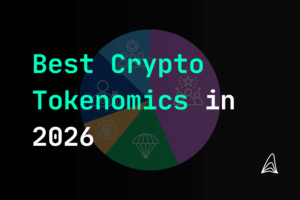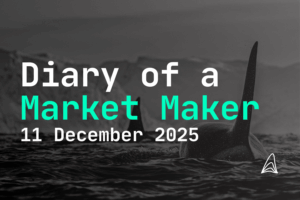Yes, smart contracts can be updated using techniques like proxy patterns, which allow the contract logic to be modified while keeping the original data intact.
- Jakob Brezigar
- Last updated: 5. September 2024
- Reading time: 6 min
Develop a Smart Contract With Crypto Market Makers
Smart contracts represent one of the most groundbreaking innovations in the blockchain space, offering a way to automate agreements without intermediaries. These self-executing contracts can transform industries by providing transparency, security, and efficiency. This guide will walk you through the process of developing a smart contract, with a focus on the programming side, ensuring that by the end, you’ll have a clear understanding of how to create, test, and deploy your smart contract.

Table of Contents
What is the most common programming language for developing smart contracts?
The most common programming language for developing smart contracts is Solidity, which is primarily used on the Ethereum blockchain. Solidity’s syntax is similar to JavaScript, making it a popular choice among developers transitioning to blockchain development.
Why is security so crucial in smart contract development?
Security is crucial because smart contracts handle valuable assets and are immutable once deployed. Vulnerabilities like reentrancy or overflows can be exploited, leading to significant financial losses.
Key Takeaways - Develop a Smart Contract:
- Clearly define your smart contract’s purpose, functions, and user interactions before diving into coding.
- Choose the right blockchain platform and programming language for your smart contract based on your project needs.
- Implement security best practices like avoiding reentrancy and setting up proper access controls.
- Thoroughly test and debug your smart contract, simulating real-world scenarios to catch potential issues early.
- Plan for upgradability and conduct security audits to ensure long-term contract performance and compliance.
Define the Smart Contract's Purpose and Functionality
Identify Core Functions of the Contract
Before diving into code, the first step in developing a smart contract is to clearly define its purpose. Whether you’re creating a token, managing an escrow service, or launching a decentralized application (dApp), knowing the contract’s primary goals will guide every other decision you make. The core functions should address specific needs. For instance, if you’re developing a token, functions like transferring tokens, checking balances, and authorizing allowances should be front and center.
It’s also vital to consider the scope of operations. Will your contract handle payments, execute trades, or manage ownership records? Defining these operations early on not only streamlines the development process but also minimizes potential bugs later. A clear blueprint ensures that the contract’s logic aligns with its intended use, preventing costly errors down the line.

Determine User Interactions and Interfaces
Next, outline how users will interact with your smart contract. This step is crucial for creating intuitive interfaces that simplify user interactions. Will users interact directly with the contract through wallets like MetaMask, or will they access it via a web interface or a mobile app? These decisions impact how you design and implement functions.
Think about the data that users need to input and the responses they expect. For instance, in a token contract, users might need to send an address and an amount to transfer tokens. On the other hand, more complex dApps might require users to engage with multiple functions across different smart contracts, necessitating a more robust user interface. Clear, well-documented interfaces make it easier for users and developers alike to understand and interact with the contract.
Choose the Right Programming Language and Platform
The blockchain ecosystem offers several programming languages and platforms, each with its strengths. The most common language for developing smart contracts is Solidity, which is used on the Ethereum blockchain. Solidity is known for its resemblance to JavaScript, making it accessible for web developers transitioning to blockchain.
Other platforms, like Hedera or Hyperledger, use different languages such as Vyper (a Pythonic alternative to Solidity) or Go. Your choice will depend on the specific requirements of your project, such as scalability, security, or integration with existing systems. Ethereum, with its widespread adoption and extensive developer community, is a popular choice for most projects. However, platforms like Binance Smart Chain, Solana, or Polkadot might be more suitable if you need faster transaction speeds or lower fees.
Design and Implement Contract Logic
Ensure Proper Handling of Inputs and Outputs
At the heart of any smart contract is its logic—the code that dictates how it processes inputs and generates outputs. When programming, it’s crucial to handle inputs and outputs correctly to prevent unintended behavior. Mismanaged data can lead to vulnerabilities that attackers might exploit. For instance, input validation is a must to avoid overflows or injection attacks that could compromise your contract.
Smart contracts operate deterministically; given the same inputs, they always produce the same outputs. Therefore, your code should be clear, concise, and free of ambiguity. Consider edge cases where inputs might be unexpected, and build safeguards into your contract logic to handle these scenarios. Testing different input combinations ensures that the contract behaves as expected under all circumstances.

Set Up Conditions and Triggers for Execution
Smart contracts rely on predefined conditions and triggers to execute specific functions. These can be simple conditions, like checking if a user has enough tokens before allowing a transfer, or complex ones involving multiple variables and states. Triggers can be time-based, event-driven, or dependent on other contracts’ outcomes.
For example, a contract might release funds from an escrow only when both parties confirm receipt of goods. Or it might trigger a token burn when a certain supply level is reached. Designing these conditions carefully ensures that the contract operates as intended, even in complex scenarios. Remember, once deployed, smart contracts are immutable, meaning you can’t change the code. So, every condition and trigger needs to be thoroughly planned and implemented before deployment.
Incorporate Security Best Practices
Avoid Common Vulnerabilities (e.g., Reentrancy, Overflow)
Security is paramount in smart contract development. A single vulnerability can lead to significant financial losses. One notorious vulnerability is reentrancy, which has been exploited in several high-profile hacks. This occurs when a function calls an external contract before updating its state, allowing the external contract to re-enter and manipulate the state.
To avoid such pitfalls, always use checks-effects-interactions patterns, where state changes occur before external calls. Additionally, be wary of integer overflow and underflow, which can cause calculations to behave unpredictably. Modern Solidity versions have safeguards, but it’s wise to remain vigilant and review your code for potential vulnerabilities.

Implement Access Control and Permissions
Not all functions in a smart contract should be accessible to everyone. Implementing access controls is crucial to ensure that only authorized users can execute specific functions. For example, only the contract owner should be able to mint new tokens or adjust critical parameters.
Roles and permissions can be implemented using modifiers in Solidity, such as only owner or custom access controls that check the sender’s address against a whitelist. This prevents unauthorized access and protects against malicious actors who might attempt to exploit your contract.
Set Up Token Standards (e.g., ERC-20, ERC-721)
If your smart contract involves creating tokens, adhering to established token standards like ERC-20 (for fungible tokens) or ERC-721 (for non-fungible tokens) is essential. These standards define a set of functions that your contract must implement, ensuring interoperability with wallets, exchanges, and other dApps.
ERC-20, for instance, requires functions like transfer, approve, and balanceOf, which allow tokens to be sent, approved for spending by others, and checked for balances. On the other hand, ERC-721 deals with unique tokens, each with its own identifier, making it ideal for NFTs (non-fungible tokens). Following these standards simplifies integration with existing crypto infrastructure, like exchanges and wallets.
Conduct Thorough Testing and Debugging
Perform Unit Tests for All Contract Functions
Testing is a critical step in smart contract development. Unit tests allow you to test each function individually, ensuring they work as intended. Solidity testing frameworks like Truffle and Hardhat provide tools for writing and running unit tests.
Testing should cover all possible scenarios, including edge cases where inputs are outside expected ranges. Unit tests help catch bugs early, reducing the risk of costly errors after deployment. By simulating how your contract will behave under different conditions, you can identify potential issues before they cause problems on the blockchain.

Simulate Real-World Scenarios to Identify Issues
Beyond unit tests, it’s important to simulate real-world scenarios. This involves testing how your smart contract interacts with other contracts, how it handles unexpected inputs, and how it performs under heavy load. Tools like Ganache allow you to create a local blockchain environment where you can deploy your contract and test it under various conditions.
Simulating real-world scenarios helps you understand how your contract will perform once it’s live, providing insights that unit tests alone might miss. For example, testing how your contract handles a high volume of transactions can reveal performance bottlenecks or issues with gas efficiency.
Plan for Contract Upgradability and Maintenance
While smart contracts are immutable by nature, planning for upgradability is possible and often necessary. Techniques such as proxy patterns allow for the logic of a contract to be updated while keeping the original data intact. This approach is essential if you anticipate needing to fix bugs, add features, or adapt to changing market conditions.
Moreover, consider setting up mechanisms for governance and maintenance. This might include creating a decentralized autonomous organization (DAO) to manage contract upgrades or implementing timelocks that delay upgrades, giving users time to review changes. Upgradability ensures your smart contract remains functional and relevant even as the surrounding ecosystem evolves.
Audit the Smart Contract for Security and Compliance
Before deploying your smart contract, an audit is crucial. Audits involve a thorough review of your code by security experts who can identify vulnerabilities and suggest improvements. Companies like Orcabay, with our developer-first approach, can be invaluable here, offering customized solutions that align with your project’s unique needs. Our fully regulated, compliant services ensure that your contract not only works as intended but also adheres to legal and industry standards.
Orcabay’s in-house algorithms and transparent reporting provide peace of mind, allowing you to monitor your project and make informed decisions based on real-time data. This hands-on approach, combined with daily monitoring and adaptation to trading activities, enhances the security and performance of your smart contract.
Disclaimer: The information provided in this article is for informational purposes only and does not constitute financial, investment, or other professional advice. All opinions expressed herein are solely those of the author and do not represent the views or opinions of any entity with which the author may be associated. Investing in financial markets involves risk, including the potential loss of principal. Readers should perform their own research and consult with a licensed financial advisor before making any investment decisions. Past performance is not indicative of future results.

Jakob Brezigar
Jakob, an experienced specialist in the field of cryptocurrency market making, boasts an extensive international presence. With Orcabay, he has skillfully managed major operations and deals for a wide array of global stakeholders.




